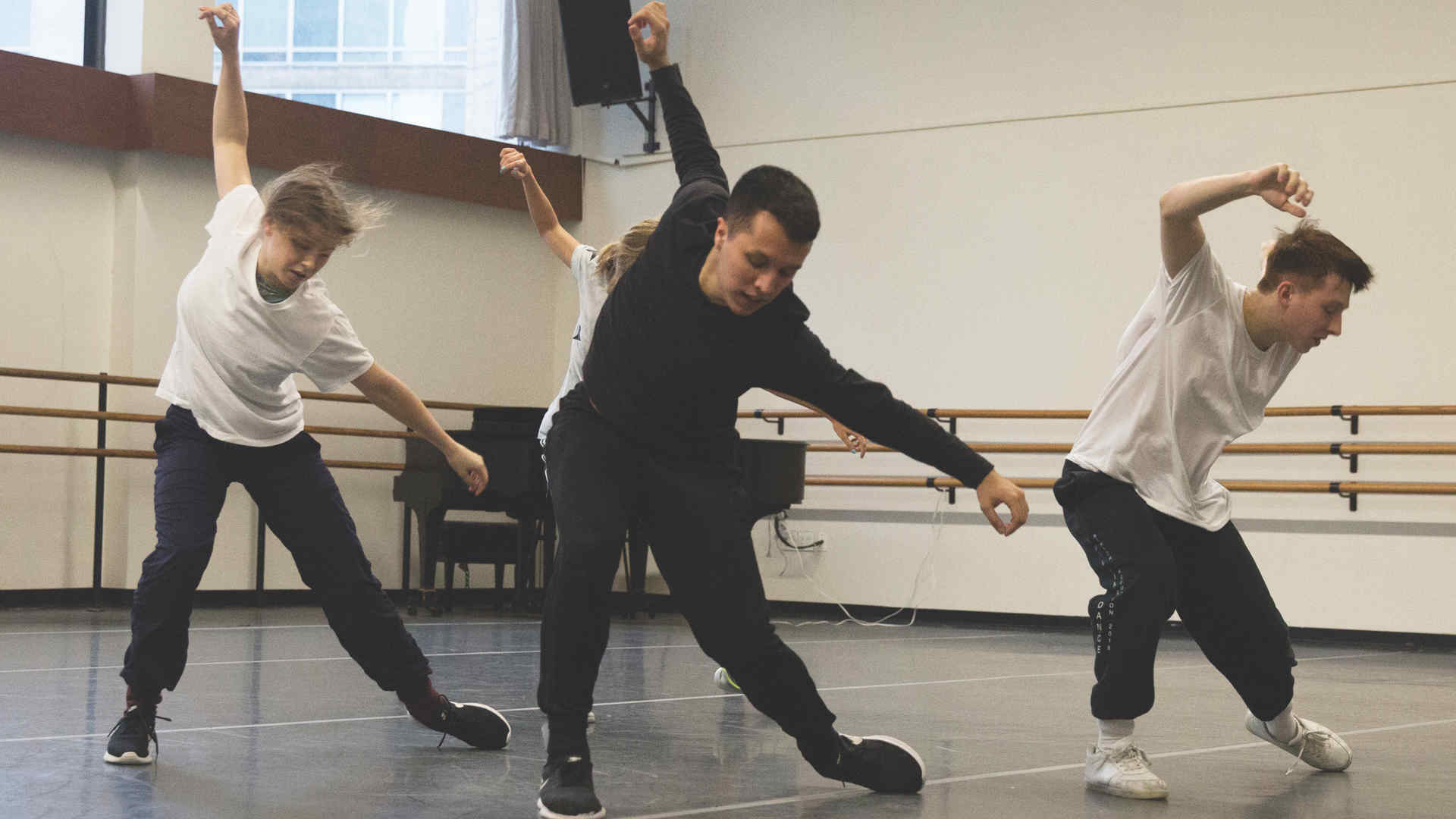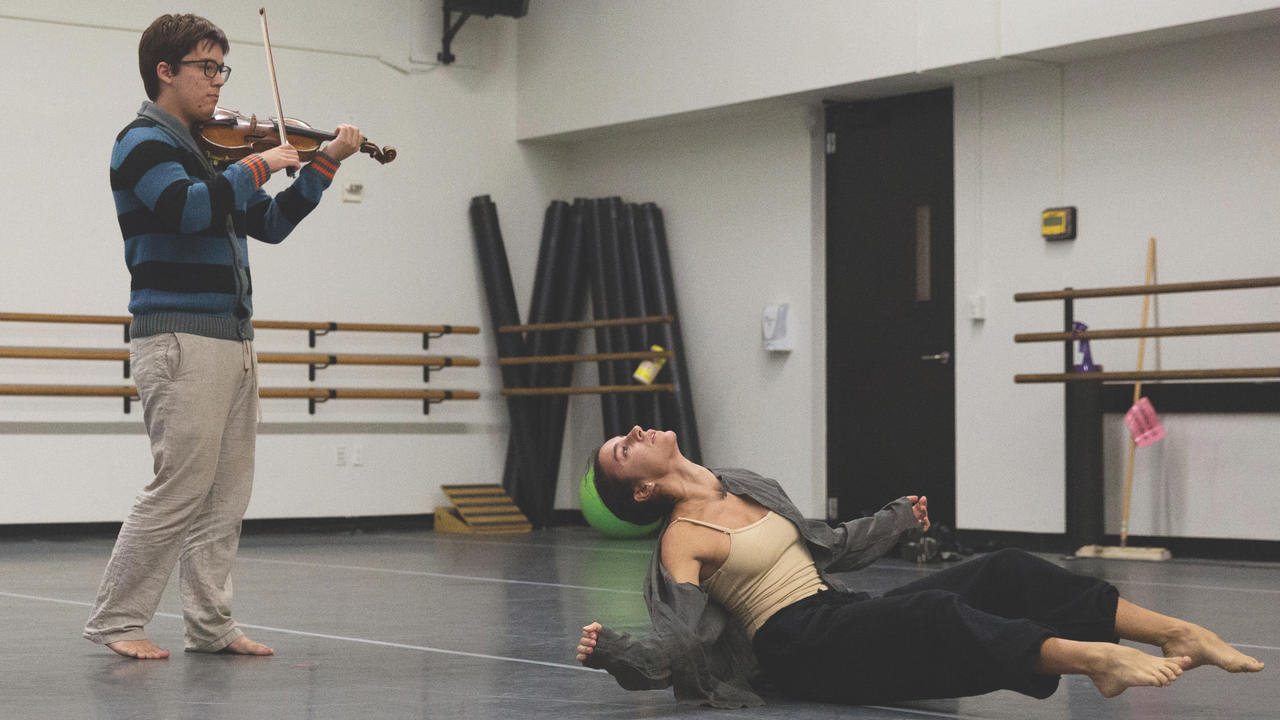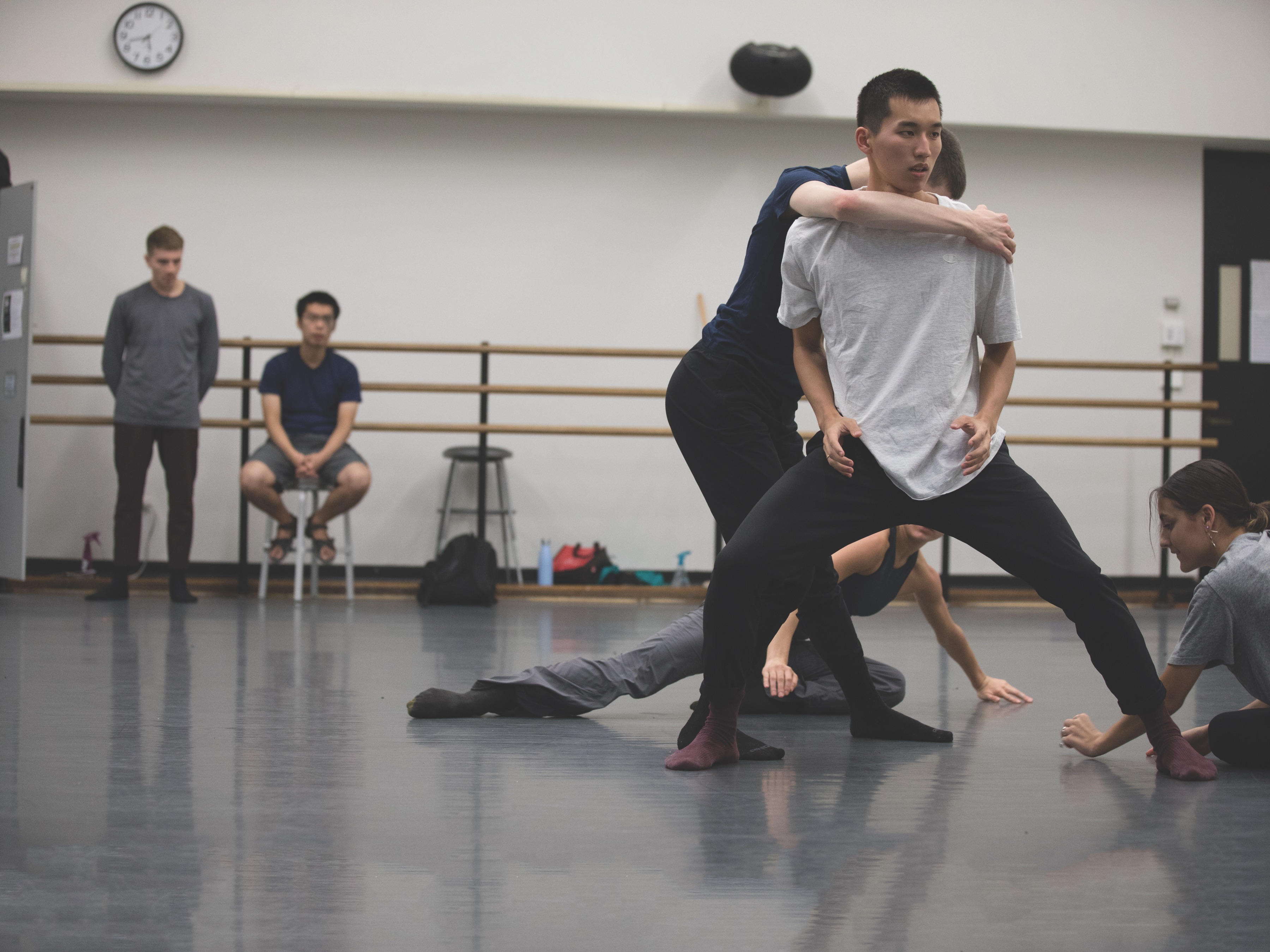
Each fall, as the culmination of a class called Choreographers and Composers, six pairs of students, one from each field, create works to be performed by their classmates. Several of them spoke about working together. Other participants this year include composers Jack Gulielmetti, Webster Gadbois, and Trey Makler, and choreographers Libby Faber, Nathan Hirschaut, and Nicolas Noguera.
By Lúa Mayenco Cardenal
Third-year composer Tengku Irfan and I met during our first semester at Juilliard—we were part of the same colloquium group and had the pleasure of creating a short piece for our final showing. I felt extremely lucky having the opportunity to exchange ideas with someone who had such a different perspective and understanding of the art world. So when we were trying to find the perfect composer-choreographer matches in our ChoreoComp pairing sessions, I felt that starting a new creative process with Irfan seemed like it would be an exciting and rewarding experience.

I’ve been in love with ChoreoComp since I was first told about this opportunity to create side by side with students who are willing to share the secrets of their craft—it’s the perfect platform to develop an idea with the support and inspiration of many other talented artists. Plus my experience in ChoreoComp as a second-year student, when I danced in a piece by choreographer Moscelyne ParkeHarrison and composer Jack Frerer, was one of the most rewarding experiences at this school. As part of this project from the other side this year, I needed to discover the challenges and adventures offered by the front of the room.
After a month of brainstorming, discussions, and rehearsals, I would say that the most challenging part of this process has been finding a clear and efficient way of communication that allows everyone to grow at the same pace. Dancers, choreographers, composers, musicians, teachers, stage crew—they all need to be aware of how the piece is evolving in order to make the best out of the time and energy dedicated to it. I’m so lucky to be working with someone who’s so willing to share, participate, and explore all the crazy ideas I put on the table.
At the moment, we’re passing through one of the most delicate phases of any creative process. It’s time to find the courage to fully commit to the ideas that we’ve explored and trust each other’s skills to make something beautiful out of what feels true to ourselves.
Dancer Lúa Mayenco Cardenal, who's working with composer Tengku Irfan, holds Nina Carasso and Cara and Hiram Lewine scholarships as well as the Lulu E. Sweigard Memorial Scholarship in Dance
By Mikey Garcia
I wanted to be involved in ChoreoComp because of the challenges and rewards that a collaborative process can produce. As a choreographer, creating and fleshing out a vision has challenges within itself; you are translating your abstract mind into the physical body, and you are simultaneously overseeing and critiquing this process. It’s a cyclical procedure of internal digging to discover and produce new ideas while also curating and organizing these thoughts in real time. A project like ChoreoComp, where you’re adding another artist into this equation, creates another layer of complexity—especially when they do not practice the same discipline as you. This increased intricacy means more decision making, more communication, and more compromise, but also heightened potential for a creation that is outside of what both artists were capable of alone. It is this stretching of possibility and of mind that made me so interested in working with a composer and participating in this project.
Dancer Mikey Garcia holds Irene Diamond and Juilliard Council scholarships; he’s working with composer Cheng Hao “Sam” Wu

By Tengku Irfan
I’m excited to be working more collaboratively and closely with Lúa, who’s not only a great dancer and choreographer but also willing to try new ventures. When she and I were trying to find an idea that holds our piece for ChoreoComp together, we both wanted to focus on the concept of a memory. This idea would come back at different times and serve a psychological purpose throughout the piece. We both have been sculpting it gradually these past few weeks to find the deeper meaning behind this idea and how this will unite the whole work.
One of the joys of working with Lúa is that we have a similar idea of how the piece might develop and that we are willing to compromise musically and choreographically to make the piece stronger and more convincing. Because there are several dancers and musicians in this piece, there is more room for experimentation. We also do our best in updating each other, be it through her listening to my musical progress or me attending as many rehearsals as I can to witness her ideas for the choreography and how it translates into dance.
Coordinating the dancers and musicians will be a challenge since the musicians are not only going to line up the music with the dance, but they are also moving and maneuvering around the space, interacting with the dancers. I would then have to think of something that is playable and idiomatic yet also meaningful to the work since they are doing multiple things at once. In general, we do our best to be clear with where we are going and yet allow ourselves to have the flexibility to change and experiment with different ideas around whenever we need to. However, I’m looking forward to seeing how all of this will come together—working with Lúa has been an amazing journey!
Composer Tengku Irfan, who's working with dancer Lúa Mayenco Cardenal, holds a Kovner fellowship

By Cheng Hao “Sam” Wu
I have always found writing music for dance particularly rewarding. Just last year, I scored an evening-length piece for the Harvard Ballet Company, and I am thrilled to be part of ChoreoComp this semester. It has been a joy to share a creative process with Mikey. As composers, we are used
to working in solitude, where the only voices we hear in our heads are our own. As Mikey’s choreography and my writing happen in parallel, I have to involve Mikey in my internal dialogues (and vice versa). Thus, witnessing the evolution of our work as a result of our conversations is fascinating, and more often than not, a pleasant surprise. In some ways, my composing is a way to reflect upon these conversations; the boundary where words end and dance/music takes over is rather blurry.
Composer Cheng Hao “Sam” Wu, who holds an Alexandre Gretchaninoff Scholarship, is working with choreographer Mikey Garcia
A project like ChoreoComp, where you’re adding another artist into this equation, creates another layer of complexity. This increased intricacy means more decision making, more communication, and more compromise, but also heightened potential for a creation outside what both artists were capable of alone. —Mikey Garcia, dancer
By Cheng Jin Koh and Dylan Croy
CJ and Dylan: We had good chemistry from our very first session together. We knew we wanted something rhythmic, and from there we started having in-depth conversations about both the dance and music. Our mutual agreement on the most important features of work pertaining to the concept and the character of the piece gave the process a clear direction. We were both willing to bend in order to reinforce the importance of the integrity of the piece while keeping our styles detectable.
Dylan: I wanted to be involved in ChoreoComp because I found the platform to be a significant stepping-stone as choreographer. I was not only intrigued by the challenge of working with a composer, but also excited by the possibilities. I think any choreographer would love an opportunity of this nature, especially one that is being curated in a safe space like Juilliard.
CJ: Coming from an arts school before Juilliard, I already had opportunities to watch dancers in my school perform and was fascinated by how they are able to communicate with just their bodies. I wanted to explore how music, as wholesome as it seems, can serve such an artistic venture. Simultaneously, it’s refreshing to take a break from the usual concert music writing. I wanted to make use of the resources I have here at Juilliard (superb artists around and great opportunities) and welcome the fruitful challenges that an actual collaboration may offer beyond my comfort zone.
CJ and Dylan: We both worked very consistently and regularly updated each other. We edited our dance and music based on what the other had, influencing each other in the process. The easiest aspect had been that communication was not only direct, but swift. We take each other’s opinions and concerns into careful consideration, and work consistently. We’re always asking each other in-depth questions that not only challenge each other but add an extra layer of quality to our work. It is both a constant challenge and a reward working together as we discover new boundaries in our art by hearing feedback from an artist of a different medium.
Dylan: The most challenging part was, initially, being afraid to reveal our true feelings or what works and what doesn’t. In reality being honest is most effective in the course of the creative work. As artists I feel we both understand how important it is to be clear in what we are trying to say. As we continue, we ask ourselves what is necessary and what contributes to the work most effectively. These are the questions that are in the forefront of every choice I make as a choreographer, collaborator, and dancer.
CJ: I had to learn how to readjust my composer mindset by making sure the music really contributed to the dance rather than being self-serving, per se. Exploring this previously uncharted terrain of nonconcert music and cultivating another version of my writing persona is tough, but it has opened my mind more to the beauty of the greater compatibility that lies ahead with every compromise, correction, and refinement. I’m glad to be working with Dylan, who is able to understand my writing language and adapt to it.
Compser Cheng Jin Koh—who holds the Piser Scholarship, the Marvin Hamlisch Scholarship in Composition, and the Milton and Sylvia Babbitt Scholarship—and dancer Dylan Croy, who holds Marion Sunshine and William J. Henderson scholarships—are working together